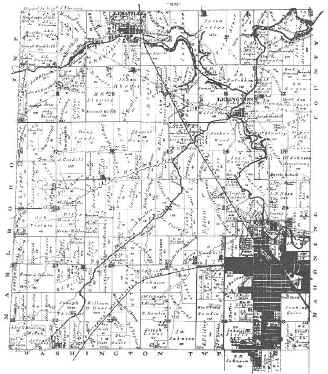 In the early 1800s the Mahoning River was larger than it is today. Expecting the river to be widened and dredged in parts to permit commercial shipping, two Quakers from Virginia, Amos Holloway and Nathan Gaskill, platted the town of Lexington on its banks in 1807. Soon John Grant, Zaccheus Stanton, Jesse Feltz and others joined them, but their dreams of a great shipping center never materialized. The town today is little larger than it was a century and a half ago.
In the early 1800s the Mahoning River was larger than it is today. Expecting the river to be widened and dredged in parts to permit commercial shipping, two Quakers from Virginia, Amos Holloway and Nathan Gaskill, platted the town of Lexington on its banks in 1807. Soon John Grant, Zaccheus Stanton, Jesse Feltz and others joined them, but their dreams of a great shipping center never materialized. The town today is little larger than it was a century and a half ago.
For the very early settlers in the township survival meant hard work. They had to build log cabins for shelter, clear the forests to make space for crops, and protect themselves from wild animals. If they wanted clothing not made of animal skins, they had to grow flax to make linen, or raise sheep for wool. In order to have their wheat ground into flour, they had to carry the grain all the way to the Ohio River--a three day trip! In 1818 a mill was constructed on the Mahoning River near the present city water works. For more than 80 years there was a mill on the site that either sawed lumber for new buildings, or ground grain for food. For most of the last 15 years of its existence it was a flour mill operated by two black men, John and Ed Cyrus.
In 1827 Williamsport became the next village to be recorded in Lexington Township. It was established by William and Martha Teeters on the north side of the Mahoning between what are now Beech and Gaskill Streets.
David Holloway founded Lima in 1830. The name was later changed to Limaville, probably because the railroads did not want the confusion of two Ohio stations with the same name. During the last part of the century the town supported a number of mills and industries, but these gradually went out of existence.
When it was recorded in 1833, half of the village of Mount Union was in Lexington Township. Mathias Hester platted the town of Freedom in 1838 and the original Alliance (sometimes called Liberty) in 1850. These three towns, along with Williamsport, later became the city of Alliance.
